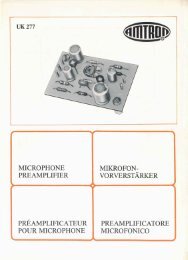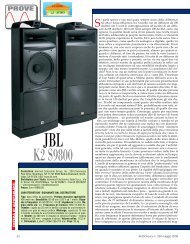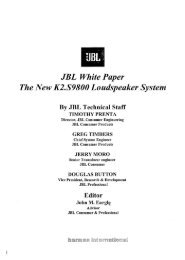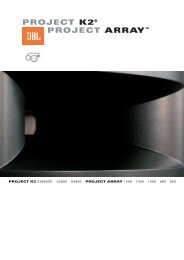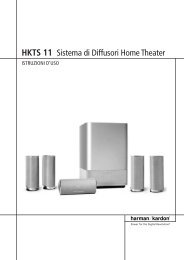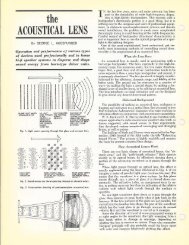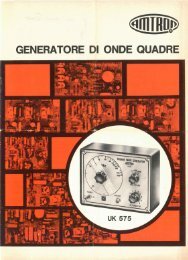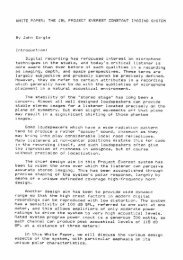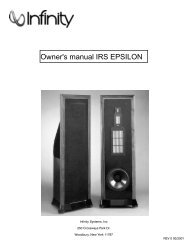MEASUREMENTS
MEASUREMENTS
MEASUREMENTS
Create successful ePaper yourself
Turn your PDF publications into a flip-book with our unique Google optimized e-Paper software.
GLOSSARY OF TELEVISION TERMS<br />
AC-COUPLED A connection which removes the<br />
constant voltage (DC component) on which the<br />
signal (AC component) is riding. Implemented by<br />
passing the signal through a capacitor.<br />
AM Amplitude Modulation (AM) is the process by<br />
which the amplitude of a high-frequency carrier is<br />
varied in proportion to the signal of interest. In the<br />
PAL television system, AM is used to encode the<br />
colour information and to transmit the picture.<br />
Several different forms of AM are differentiated by<br />
various methods of sideband filtering and carrier<br />
suppression. Double sideband suppressed carrier is<br />
used to encode the PAL colour information, while the<br />
signal is transmitted with a large-carrier vestigial<br />
sideband scheme.<br />
APL Average Picture Level. The average signal level<br />
(with respect to blanking) during active picture time,<br />
expressed as a percentage of the difference between<br />
the blanking and reference white levels.<br />
BACK PORCH The portion of the video signal that<br />
lies between the trailing edge of the horizontal sync<br />
pulse and the start of the active picture time. Burst is<br />
located on back porch.<br />
BANDWIDTH The range of frequencies over<br />
which signal amplitude remains constant (within<br />
some limit) as it is passed through a system.<br />
BASEBAND Refers to the composite video signal<br />
as it exists before modulating the picture carrier.<br />
Composite video distributed through a studio and<br />
used for recording is at baseband.<br />
BLACK BURST Also called "colour black", black<br />
burst is a composite video signal consisting of all<br />
horizontal and vertical synchronisation information<br />
and burst. Typically used as the house reference<br />
sychronisation signal in television facilities.<br />
BLANKING LEVEL Refers to the 0.3 volt level<br />
(with respect to sync tip) which exists before and<br />
after horizontal sync and during the vertical interval.<br />
BREEZEWAY The portion of the video signal that<br />
lies between the trailing edge of the horizontal sync<br />
pulse and the start of burst. Breezeway is part of<br />
back porch.<br />
BROAD PULSES Another name for the vertical<br />
synchronising pulses in the center of the vertical interval.<br />
These pulses are long enough to be distinguished<br />
from all others, and are the part of the signal actually<br />
detected by vertical sync separators.<br />
BRUCH BLANKING A 4-field burst blanking<br />
sequence employed in PAL signals to ensure that burst<br />
phase is the same at the end of each vertical interval.<br />
BURST A small reference packet of the subcarrier<br />
sine wave sent during the horizontal blanking interval<br />
on every line of video. Since the carrier is suppressed,<br />
this phase and frequency reference is required for<br />
synchronous demodulation of the colour difference<br />
signals in the receiver.<br />
B-Y One of the colour difference signals used in the<br />
PAL system, obtained by subtracting luminance (Y)<br />
from the blue camera signal (B).<br />
CHROMINANCE Chrominance refers to the colour<br />
information in a television picture. Chrominance can<br />
be further broken down into two properties of colour,<br />
hue and saturation.<br />
CHROMINANCE SIGNAL The high frequency<br />
portion of the video signal, obtained by quadrature<br />
amplitude modulation of a 4.43 MHz subcarrier with<br />
R-Y and B-Y information.<br />
COLOUR BLACK See Black Burst.<br />
COLOUR DIFFERENCE SIGNALS Signals used<br />
by colour television systems to convey colour information<br />
in such a way that the signals go to zero<br />
when there is no colour in the picture. U and V are<br />
colour difference signals.<br />
COMPONENT VIDEO Video which exists in the<br />
form of three separate signals, all of which are required<br />
in order to completely specify the colour picture. For<br />
example: R, G and B or Y, R-Y and B-Y.<br />
COMPOSITE VIDEO A single video signal containing<br />
all of the necessary information to reproduce<br />
a colour picture. Created by adding quadrature<br />
amplitude modulated U and V to the luminance signal.<br />
CW Continuous Wave. Refers to a separate subcarrier<br />
sine wave used for synchronisation of chrominance<br />
information.<br />
dB (DECIBEL) A decibel is a logarithmic unit used<br />
to describe signal ratios. For voltages,<br />
dB = 20 Log 10 (V, N 2 ).<br />
DC-COUPLED A connection configured so that<br />
both the signal (AC component) and the constant<br />
voltage on which it is riding (DC component) are<br />
passed through.<br />
71



